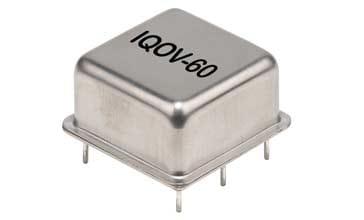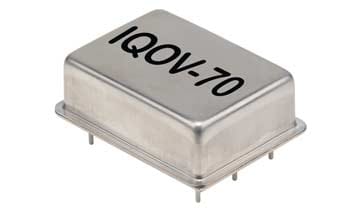OCXO, Oven Controlled Crystal Oscillator
The OCXO, Oven Controlled Crystal Oscillator provides the highest stability of any crystal oscillator.
Home » Electronic components » this page
Quartz Crystals, Xtals Tutorial Includes:
Quartz crystals: xtals
What is quartz
How a crystal works
Crystal overtone operation
Quartz crystal frequency pulling
Quartz crystal cuts
Quartz ageing
Crystal resonator manufacture
How to specify a quartz crystal
VCXO
TCXO
OCXO
Crystal filter
Monolithic crystal filter
Ceramic resonator & filter
Ceramic filter specifications
The oven controlled crystal oscillator is able to provide exceedingly high levels of temperature stability. Using an thermostatically controlled oven to keep its temperature above the surrounding and hence at a constant temperature, the OCXO a very stable signal source.
The OCXO gains its abbreviations from the term Oven Controlled crystal (Xtal) Oscillators.
OCXOs are normally designed to the highest standards, using high tolerance quartz crystal resonators. In view of the additional oven hardware and high tolerance crystals, they are much more expensive than other forms of crystal oscillator. They a
As with many other crystal based products, OCXOs are available in a widely variation of packages and package styles. The performance levels and costs also need to be considered as these can vary considerably as well.

Quartz crystal frequency stability
The resonant frequency of a quartz crystal varies with frequency, even though they are relatively small when compared to other LC resonant circuits, etc.
The degree of variation is highly dependent upon the way the crystal is cut during manufacture. The angles of the plane of the blank with reference to the axes of the original crystal determine many of its properties. These include the mode of vibration, the degree of the piezo-electric effect - i.e. its activity, and of course the temperature stability.
A crystal cut known as the AT cut is used in many general purpose applications as it exhibits a good temperature stability profile for many room temperature applications as its profile shows a low change around 20°C.

As most crystal ovens are run at temperatures well above 20°C, the AT cut crystal is not as suitable for use in oven controlled crystal oscillator applications.
In the 1970s other cuts including the SC cut were developed. This Stress Compensated, SC, quartz crystal cut is less sensitive to mechanical and thermal stress giving it a much more suitable performance for OCXO operation. In addition to this it has a lower temperature turning point, LTTP with a very shallow slope in the range 70 to 85°C where many OCXOs run. The reason that the slope is shallow is that the infection temperature is in the region of 90°C as opposed to 25°C in the case of the AT cut crystal.
More recently another cut, termed the IT cut has been developed. This overcomes issues with the requirement for the LTTP to approach the inflection temperature. To address this issue the IT cut, has an upper temperature turning point in the range of 85 to 105°C. However it is not totally ideal because it does not provide the lower level of mechanical stress sensitivity of the SC cut.
OCXO, TCXO stability comparison
Different applications will require different levels of performance. In some cases a crystal oscillator alone may be satisfactory, whereas for other applications a temperature compensated oscillator may be needed. For the highest specification requirements an oven controlled oscillator may be needed.
| Comparison of Xtal Oscillator, TCXO & OCXO Temperature Stability Performance | |||
|---|---|---|---|
| Temperature range | Basic crystal oscillator | TCXO | OCXO |
| 0C to 70C | ±10 ppm | ±0.5 ppm | ±0.003 ppm |
| -20°C to 70°C | ± 25ppm | ± 0.5ppm | ± 0.02ppm |
| -40°C to 85°C | ± 30ppm | ± 1ppm | ± 0.003ppm |
For applications that need even higher levels of stability, options including rubidium standards or some off-air GPS standards may provide the required levels of accuracy.
OCXO basics
Despite this it is still sometimes necessary to ensure a better degree of stability. This can be achieved by placing the crystal in a thermally insulated container with a thermostatically controlled heater. By heating the crystal to a temperature above that which would normally be encountered within the electronic equipment the temperature of the crystal can be maintained at a constant temperature. This results in a far greater degree of temperature stability. Additionally the crystal in the OCXO will be cut to ensure that its temperature stability is optimised for the internal operating temperature.
Commonly the internal temperature for a crystal oven is run at a temperature of 75°C or possibly 85°C.
The temperature needs to be above the highest temperature likely to be encountered, otherwise the temperature control will not work.

The typical specification for an OCXO might be ±5 x 10-8 per degree Celsius (0.05 ppm), whereas a non-oven controlled oscillator may be between 10 and 100 times poorer. As the oscillator assembly will also contain buffering circuitry as well as supply voltage regulation the other characteristics of the oscillator should also be good. Typically it might be expected that frequency stability would be around ±5 x 10-9 (0.005 ppm) per day and ±5 x 10-7 (0.5 ppm) per year and 1 x 10-7 for a 5% change in supply voltage. All of these are far better than would be expected from a simple crystal oscillator.
In order to ensure that the optimum overall accuracy is maintained, combating elements such as ageing of the crystal itself, a periodic calibration of the OCXO may be required. Typical calibration periods may be of the order of six months to a year, but the actual period will depend upon the OCXO itself and the requirements of the application in which it is being used.
OCXO general considerations
OCXOs provide a much improved level of performance when compared to other forms of crystal oscillator. However there are a number of points to be considered when choosing to use one. Some of the advantages, disadvantages and other considerations are outlined below:
Advantages of OCXOs:
- Temperature stability: In view of the use of the temperature controlled oven, the temperature stability of an OCXO s very much better than that of a TCXO and certainly an ordinary crystal oscillator.
- Frequency accuracy: As the temperature stability of OCXOs is far better than other forms of crystal oscillator, it is sense to match the improved temperature stability with high accuracy quartz crystals to ensure a high level of basic accuracy.
- Overall performance: As the improved temperature stability of OCXOs adds additional cost to the unit (the oven and additional circuitry as well as mechanical items), the overall performance is normally enhanced to match the improved temperature stability.
Disadvantages of OCXOs:
- Cost: In view of the additional circuitry and mechanical items needed along with higher performance crystals, the OCXO is not normally a low cost item. Some high performance models may cost $100 or very much more.
- Size: OCXOs are physically much larger than a simple crystal oscillator. Not only do they need to incorporate the crystal oscillator itself, but also the heater, control circuitry and the thermal insulation around the crystal oscillator.
- Power consumption: The supply for the heater in the OCXO may be quite current hungry. Some units may require an Amp or so on warm up. This figure will reduce as the temperature inside the OCXO rises and less heat is needed. As will be imagined the temperature is thermostatically controlled.
- Separate power supply: Often the OCXO heater will be run from a different supply to the oscillator. It does not need the same level of regulation, and indeed the oscillator is most likely to have its own regulator to remove any stray noise and RF that may appear on the supply line and thereby degrade the performance of the OCXO.
OCXOs, Oven Controlled Crystal Oscillators are ideal for use where high stability and performance are required from a crystal oscillator. OCXOs are normally used as signal references in variety of items of equipment where high accuracy and temperature stability is needed. Obviously this comes at a cost, but where the performance is required, the OCXO is needed.
 Written by Ian Poole .
Written by Ian Poole .
Experienced electronics engineer and author.
More Electronic Components:
Batteries
Capacitors
Connectors
ADC
DAC
Diodes
FET
Inductors
Memory types
Phototransistor
Quartz crystals
Relays
Resistors
RF connectors
Switches
Surface mount technology
Thyristor
Transformers
Transistor
Unijunction
Valves / Tubes
Return to Components menu . . .



